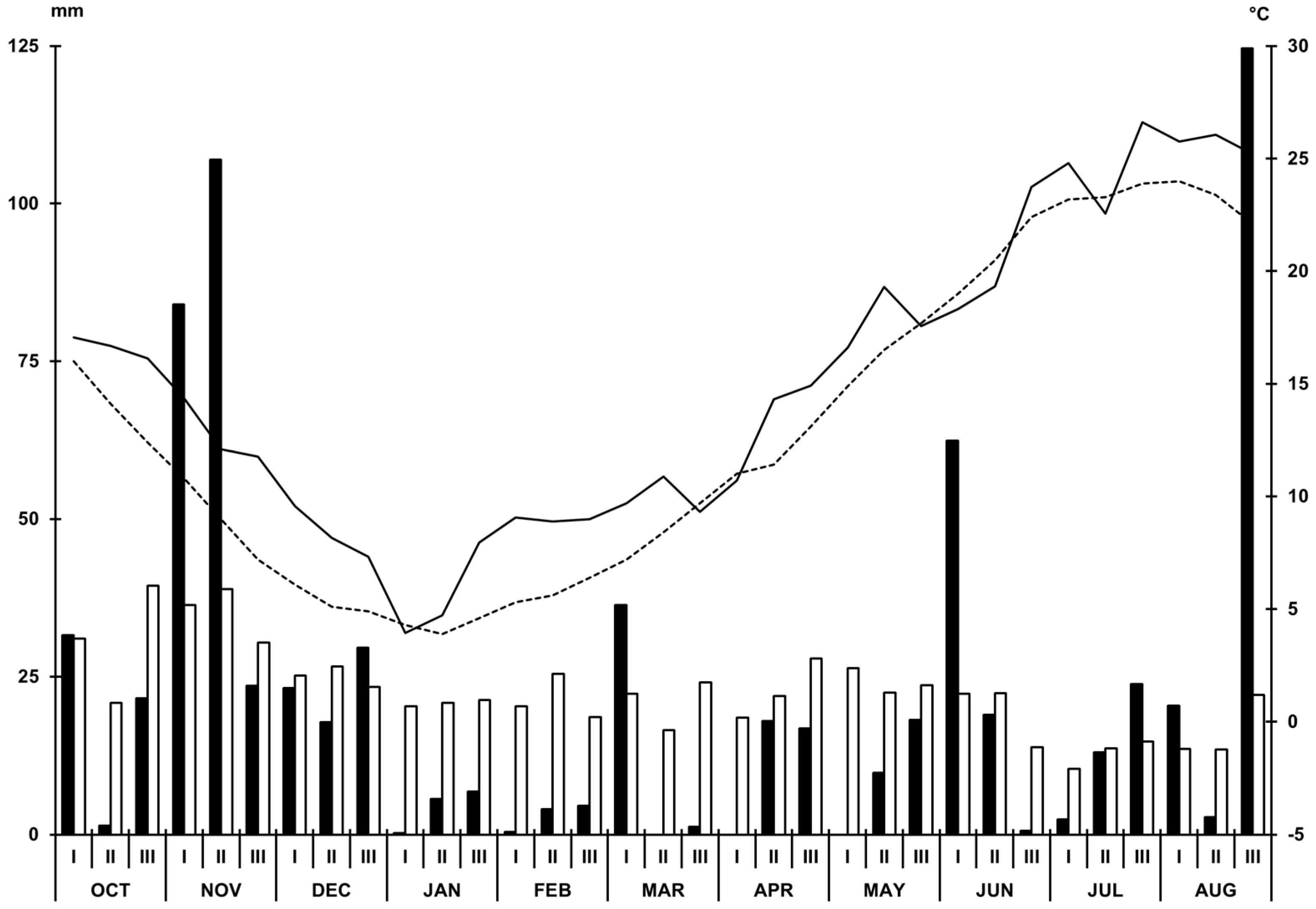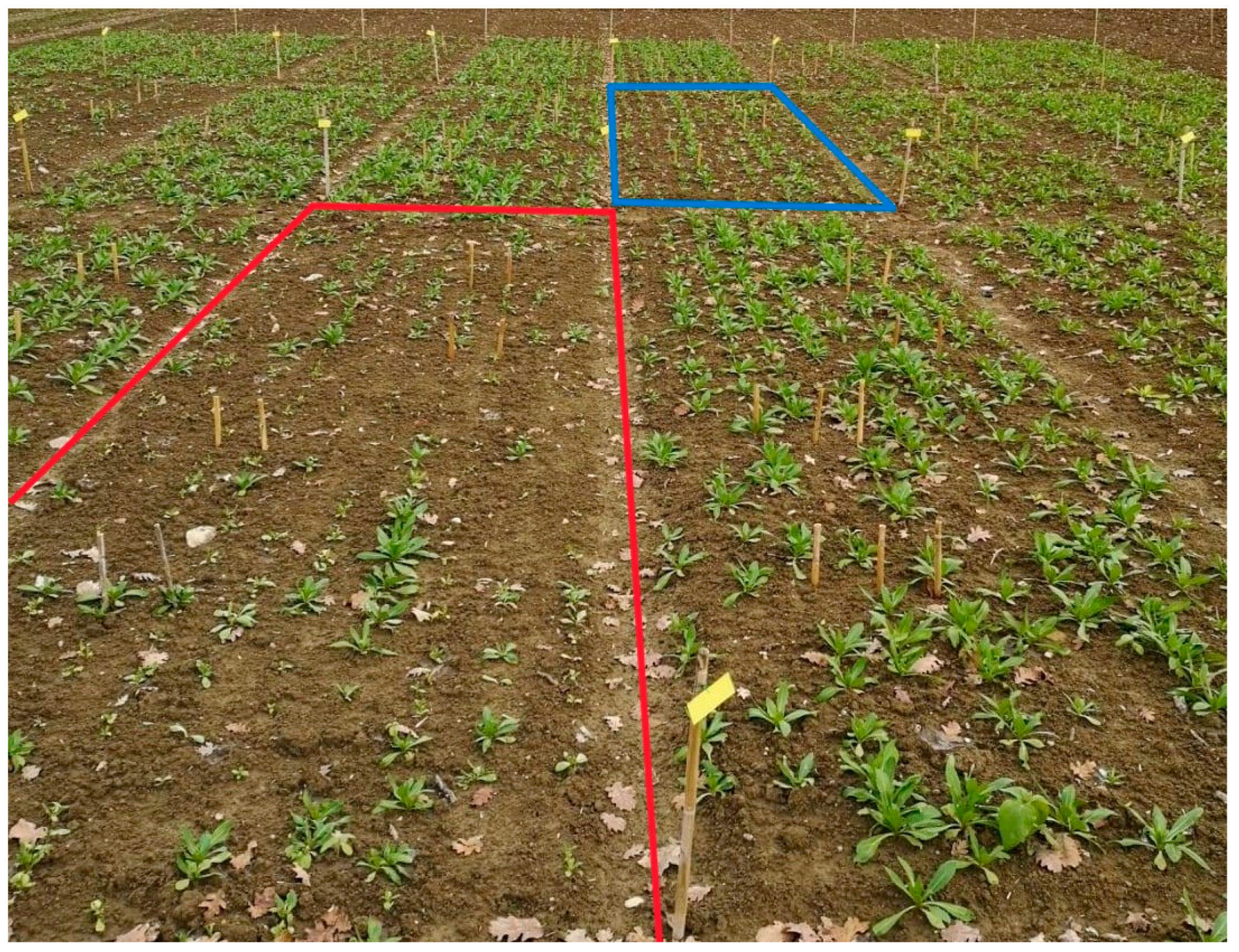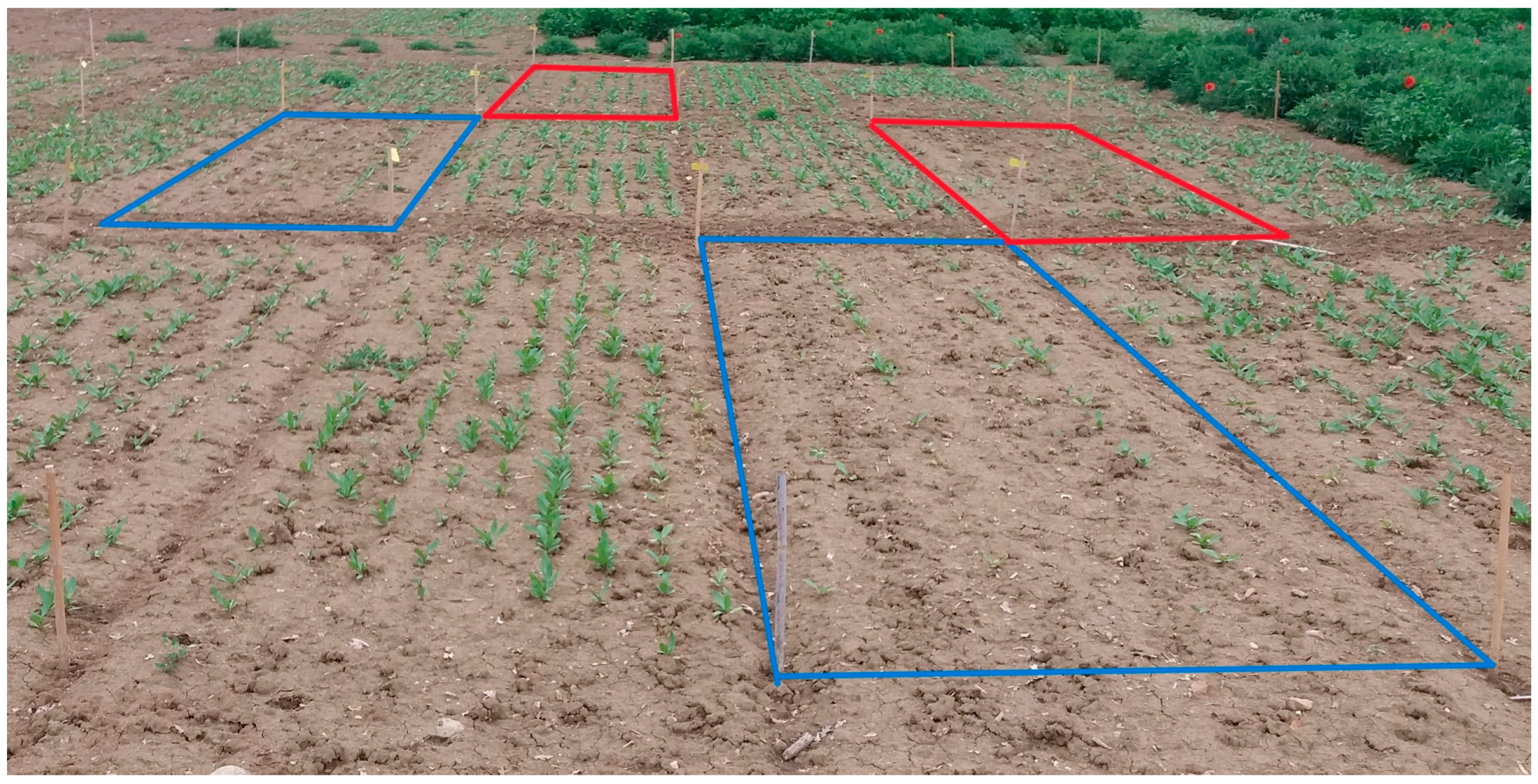Effects of Pre-Emergence Herbicides on Weed Control and Yield of Safflower (Carthamus tinctorius L.) in Central Italy
Abstract
1. Introduction
2. Materials and Methods
3. Results
3.1. Weed Control Efficacy of Herbicide Treatments
3.2. Phytotoxicity to Safflower
3.3. Safflower Grain Yield
4. Discussion
5. Conclusions
Author Contributions
Funding
Data Availability Statement
Conflicts of Interest
References
- Fernández-Martinez, J.; del Rio, M.; de Haro, A. Survey of safflower (Carthamus tinctorius L.) germplasm for variants in fatty acid composition and other seed characters. Euphytica 1993, 69, 115–122. [Google Scholar] [CrossRef]
- Zehra, E. Resurgence of Safflower (Carthamus tinctorius L.) Utilization: A Global View. J. Agron. 2005, 4, 83–87. [Google Scholar] [CrossRef]
- Ilkılıç, C.; Aydın, S.; Behcet, R.; Aydin, H. Biodiesel from Safflower oil and its application in a diesel engine. Fuel Process. Technol. 2011, 92, 356–362. [Google Scholar] [CrossRef]
- Abou Chehade, L.; Angelini, L.G.; Tavarini, S. Genotype and Seasonal Variation Affect Yield and Oil Quality of Safflower (Carthamus tinctorius L.) under Mediterranean Conditions. Agronomy 2022, 12, 122. [Google Scholar] [CrossRef]
- Rocchi, L.; Farneselli, M.; Paolotti, L.; Falcinelli, B.; Guiducci, M.; Boggia, A. Life Cycle Inventory for Safflower Production in Southern Europe. Environ. Clim. Technol. 2022, 26, 862–870. [Google Scholar] [CrossRef]
- Food and Agriculture Organization (FAO) of United Nations. The Food and Agriculture Organization Corporate Statistical Database Production Quantities of Safflower Seed and Plantains. 2021. Available online: http://www.fao.org/faostat/en/#data/QC (accessed on 10 July 2023).
- Helm, J.L.; Riveland, N.; Schneiter, A.A.; Sobolik, F. Safflower Production; Crop Extension Service, North Dakota State University: Fargo, ND, USA, 1985; p. 4. [Google Scholar]
- Budak, I.; Serim, A.; Asav, Ü. The Critical Period for Weed Control in Safflower Fields of Turkey. C. R. Acad. Bulg. Sci. 2023, 76, 1935–1942. [Google Scholar] [CrossRef]
- Anderson, R.L. Chlorsulfuron for weed control in safflower (Carthamus tinctorius). Weed Sci. 1985, 33, 840–842. [Google Scholar] [CrossRef]
- Blackshaw, R.E.; Derksen, D.A.; Muendel, H. Herbicides for weed control in safflower (Carthamus tinctorius). Can. J. Plant Sci. 1990, 70, 237–245. [Google Scholar] [CrossRef]
- Yau, S.K.; Haidar, M.A. Evaluation of Weed Management Practices for Rain-Fed Safflower Production in a Semiarid Mediterranean Environment. Agron. J. 2008, 100, 1430–1435. [Google Scholar] [CrossRef]
- Montemurro, P.; Fracchiolla, M. Further results of research on chemical weed control in safflower (Carthamus tinctorius L.). In Safflower: A Multipurpose Species with Unexploited Potential and World Adaptability, Proceedings of the IV International Safflower Conference, Bari, Italy, 2–7 June 1997; Corleto, A., Mündel, H.H., Kalpana Sastry, R., Riveland, N., Tanaka, D.L., Fernández-Martínez, J., Zhang, L.P., Esendal, E., Hill, A.B., Eds.; Adriatica Editrice: Bari, Italy, 1997; pp. 132–135. Available online: https://docplayer.net/76561821-Safflower-a-multipurpose-species-with.html (accessed on 15 December 2023).
- Pannacci, E.; Graziani, F.; Covarelli, G. Use of herbicide mixtures for pre and post-emergence weed control in sunflower (Helianthus annuus). Crop Prot. 2007, 26, 1150–1157. [Google Scholar] [CrossRef]
- van der Maarel, E. Transformation of cover-abundance values in phytosociology and its effects on community similarity. Vegetation 1979, 39, 97–114. [Google Scholar] [CrossRef]
- Chinnusamy, N.; Chinnagounder, C.; Krishnan, P.N. Evaluation of weed control efficacy and seed cotton yield in glyphosate tolerant transgenic cotton. Am. J. Plant Sci. 2013, 4, 1159–1163. [Google Scholar] [CrossRef]
- Onofri, A.; Pannacci, E. Spreadsheet tools for biometry classes in crop science programmes. Commun. Biometry Crop. Sci. 2014, 9, 3–13. [Google Scholar]
- Jha, P.; Kumar, V.; Lim, C.A.; Yadav, R. Evaluation of Preemergence Herbicides for Crop Safety and Weed Control in Safflower. Am. J. Plant Sci. 2017, 8, 2358–2366. [Google Scholar] [CrossRef]
- Budak, I.; Serim, A.T.; Asav, U. Determination of the efficacy of some herbicides on the weeds in safflower. Plant Prot. Bull. 2020, 60, 81–87. [Google Scholar] [CrossRef]
- Krenchinski, F.H.; Pereira, V.G.C.; Giovanelli, B.F.; Mattiuzzi, M.D.; Albrecht, A.J.P.; Wagner, F.G. Seletividade de herbicidas na cultura do cártamo. Rev. Bras. De Herbic. 2019, 18, 636-1. [Google Scholar] [CrossRef]
- Heuston, P.; Macpherson, M. Weed Control in Winter Crops 2024. NSW Department of Primary Industries, Management Guide. Pages 159. Available online: https://www.dpi.nsw.gov.au/agriculture/broadacre-crops/guides/publications/weed-control-winter-crops (accessed on 20 February 2024).
- US EPA, Pesticide Product Label, S-Metolachlor EC Herbicide, 01/09/2023. Available online: https://www3.epa.gov/pesticides/chem_search/ppls/082542-00036-20230109.pdf (accessed on 15 December 2023).
- Rosenfeld, P.E.; Feng, L.G.H. Risks of Hazardous Wastes; William Andrew: Norwich, NY, USA, 2011; pp. 127–154. [Google Scholar] [CrossRef]



| Agronomic Practices | Experiment 1 (Autumn Sowing) | Experiment 2 (Spring Sowing) |
|---|---|---|
| Preceding crop | wheat | wheat |
| Sowing date | 22 October 2019 | 2 April 2020 |
| Safflower cultivar | CW99-OL (semfor s.r.l.) | CW99-OL (semfor s.r.l.) |
| Density (plants ⋅ ha−2) | 50 | 50 |
| Emergence date | 2 November 2019 | 17 April 2020 |
| Herbicide treatments date | 24 October 2019 | 3 April 2020 |
| Fertilization (kg ⋅ ha−1): | ||
| P2O5 (pre-sowing time application) | 75 | 75 |
| N (post-emergence application) | 100 | 100 |
| Harvest | 3 August 2020 | 11 August 2020 |
| Code | Herbicides | HRAC Group/MoA | Product Information | Dose (g a.i. ⋅ ha−1) |
|---|---|---|---|---|
| A | untreated control | - | - | - |
| B | aclonifen | 32/Inhibition of Solanesyl Diphosphate Synthase | Challenge (60% a.i., Bayer CropScience) | 1800 |
| C | metazachlor | 15/Inhibition of Very Long-Chain Fatty Acid Synthesis | Butisan S (50% a.i., BASF Italia) | 1000 |
| D | s-metolachlor | 15/Inhibition of Very Long-Chain Fatty Acid Synthesis | Dual Gold (96% a.i., Syngenta Crop Protection) | 960 |
| E | propyzamide | 3/Inhibition of Microtubule Assembly | Kerb Flo (40% a.i., Corteva Agriscience Italia) | 1000 |
| F | metribuzin | 5/Inhbition of Photosynthesis at PSII-Serine 264 Binders | Mesozin 70 WG (70% a.i., Corteva Agriscience Italia) | 245 |
| Treatment | Code | Weed Control Efficacy (%) | ||||
|---|---|---|---|---|---|---|
| PAPRH | CONCA | AMIMA | Other | Total | ||
| aclonifen | B | 100 a | 0 b | 66 | 38 | 46 b |
| metazachlor | C | 100 a | 99 a | 100 | 33 | 92 a |
| s-metolachlor | D | 100 a | 82 a | 100 | 90 | 97 a |
| propyzamide | E | 24 b | 99 a | 94 | 81 | 47 b |
| metribuzin | F | 34 b | 0 b | 94 | 81 | 40 b |
| S.E.M. (df = 14) | 13 | 7 | 15 | 22 | 11 | |
| LSD (p = 0.05) | 43 | 23 | n.s. | n.s. | 34 | |
| Treatment | Code | HELAN | |
|---|---|---|---|
| Density (plant ⋅ m−2) | Ground Cover (%) | ||
| untreated control | A | 1.3 | 11.3 |
| aclonifen | B | 1.1 | 6.3 |
| metazachlor | C | 1.1 | 11.3 |
| s-metolachlor | D | 1.3 | 9.2 |
| propyzamide | E | 2.0 | 22.1 |
| metribuzin | F | 1.0 | 22.5 |
| S.E.M. (df = 17) | 0.4 | 8.1 | |
| LSD (p = 0.05) | n.s. | n.s. | |
| Treatment | Code | Herbicide Phytotoxicity (Scale 0–100%) | Safflower Density (plant ⋅ m−2) | ||
|---|---|---|---|---|---|
| 45 DAE | 90 DAE | 40 DAE | 160 DAE | ||
| untreated control | A | 0 d | 0 c | 49 | 17 |
| aclonifen | B | 0 d | 5 c | 66 | 21 |
| metazachlor | C | 75 a | 75 a | 53 | 17 |
| s-metolachlor | D | 0 d | 5 c | 56 | 25 |
| propyzamide | E | 10 c | 5 c | 59 | 17 |
| metribuzin | F | 30 b | 43 b | 57 | 21 |
| S.E.M. (df = 17) | 4 ⋅ 10−7 | 3.1 | 4.3 | 3.3 | |
| LSD (p = 0.05) | 1 ⋅ 10−6 | 9.6 | n.s. | n.s. | |
| Treatment | Code | Herbicide Phytotoxicity (Scale 0–100%) | Safflower Density (Plant ⋅ m−2) |
|---|---|---|---|
| untreated control | A | 0 d | 48 a |
| aclonifen | B | 5 cd | 53 a |
| metazachlor | C | 48 b | 27 bc |
| s-metolachlor | D | 0 d | 53 a |
| propyzamide | E | 8 c | 41 ab |
| metribuzin | F | 75 a | 12 c |
| S.E.M. (df = 17) | 1.6 | 5.6 | |
| LSD (p = 0.05) | 5.2 | 17.6 |
| Treatment | Code | Grain Yield (kg ⋅ ha−1) | |
|---|---|---|---|
| Exp. 1 | Exp. 2 | ||
| untreated control | A | 1429 c | 1536 a |
| aclonifen | B | 2442 a | 1493 a |
| metazachlor | C | 2317 ab | 1108 b |
| s-metolachlor | D | 2444 a | 1517 a |
| propyzamide | E | 1516 c | 1430 a |
| metribuzin | F | 1756 bc | 810 c |
| S.E.M. (df = 17) | 212 | 94 | |
| LSD (p = 0.05) | 669 | 295 | |
Disclaimer/Publisher’s Note: The statements, opinions and data contained in all publications are solely those of the individual author(s) and contributor(s) and not of MDPI and/or the editor(s). MDPI and/or the editor(s) disclaim responsibility for any injury to people or property resulting from any ideas, methods, instructions or products referred to in the content. |
© 2024 by the authors. Licensee MDPI, Basel, Switzerland. This article is an open access article distributed under the terms and conditions of the Creative Commons Attribution (CC BY) license (https://creativecommons.org/licenses/by/4.0/).
Share and Cite
Pannacci, E.; Farneselli, M.; Monni, V.; Tei, F. Effects of Pre-Emergence Herbicides on Weed Control and Yield of Safflower (Carthamus tinctorius L.) in Central Italy. Agronomy 2024, 14, 482. https://doi.org/10.3390/agronomy14030482
Pannacci E, Farneselli M, Monni V, Tei F. Effects of Pre-Emergence Herbicides on Weed Control and Yield of Safflower (Carthamus tinctorius L.) in Central Italy. Agronomy. 2024; 14(3):482. https://doi.org/10.3390/agronomy14030482
Chicago/Turabian StylePannacci, Euro, Michela Farneselli, Vittorio Monni, and Francesco Tei. 2024. "Effects of Pre-Emergence Herbicides on Weed Control and Yield of Safflower (Carthamus tinctorius L.) in Central Italy" Agronomy 14, no. 3: 482. https://doi.org/10.3390/agronomy14030482
APA StylePannacci, E., Farneselli, M., Monni, V., & Tei, F. (2024). Effects of Pre-Emergence Herbicides on Weed Control and Yield of Safflower (Carthamus tinctorius L.) in Central Italy. Agronomy, 14(3), 482. https://doi.org/10.3390/agronomy14030482







